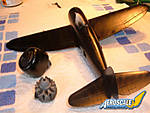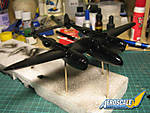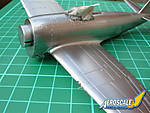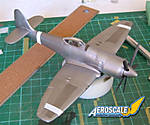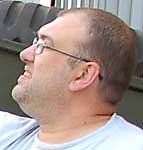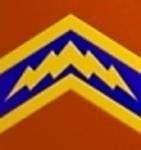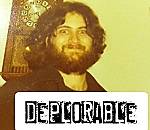Alclad Adventures
19
Comments
Applying Alclad
All models featured here are 1:72 scale. Mostly built straight from the box although some have extra details here and there. I wont highlight these as this articles about using Alclad2 and I donít want to detract from that.The first NMF I attempted was an OOB build of Tamiyas P-47D Bubbletop. The base coat for this was Alclad2 Polished Aluminium.
The Alclad website recommends a gloss black primer when using either Polished Aluminum or Chrome lacquers. Although I had purchased a can of Alclads own black primer to use during this build I had, while researching Alclad builds, come across references to issues with this primer not drying properly, so I elected to prime with Tamiya Gloss Black Acrylic.
I have no personal experience to either confirm or deny the reported issues with Alclad primer, as Taimya Gloss Black has become my preferred undercoat for Alclad, and this is not a reflection on the Alclad product.
After leaving to dry overnight or longer, its time to shoot some of the Alclad lacquer. Or is it?
First things first.
Always spray Alclad in a well ventilated area.
Always wear a mask.
Always follow the manufacturers instructions.
Alclad comes ready to spray, so there's no need to thin it. Just empty a small amount into your paint reservoir and its good to go. I usually spray Alclad at about 5 psi or lower.
Gradually mist the lacquer onto the model rather than going for immediate coverage. Spray from about 6 inches away and slowly build up the coverage. It takes a lot less paint to achieve an even coverage than youíd expect.
Donít overdo it. Remember itís very easy to mist some more lacquer onto the model. To remove it is another story altogether.
In summary.
Gradually mist the Alclad onto the model. Less really is more with this stuff. One of its quirks is that once youíve made a pass over the models surface with Alclad2 it seems to take a few seconds before it appears. I'm sure there's a perfectly understandable scientific reason behind this phenomenon but l am not going to attempt to understand it. Maybe there's a leak in my mask!
Comments
Thanks Nigel I will have to give that a try when I get round to the 1/24 Mustang. be prepared for more questions
JUL 20, 2008 - 07:14 PM
This may help...
Here's some scans of the instructions that I got wrapped round a bottle of Alclad once.
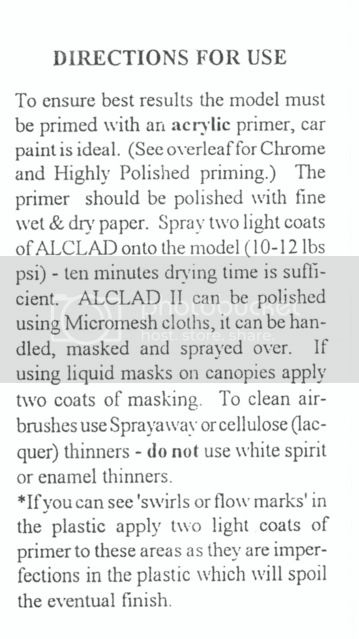
 Cheers
Allen
Cheers
Allen

 Cheers
Allen
Cheers
AllenAUG 09, 2008 - 08:15 AM
Oh boy did I just screw it up... used the alclad and everything went fine and dandy then used a bit of mm plate alum. and the world blew up it crazed. well I think it is salvageable but for now this superbolt is back in the box .... what a bummer this day became. live and learn i guess
Kelly
NOV 25, 2008 - 06:32 AM
Hmmm I never knew you used alcohol to clean your airbrush after using Alclad.. Might give it a go now.
Thanks Nige
SEP 25, 2011 - 10:46 AM
Hi Warren.
Yep, Isoproyl alcohol works a treat.
I also use it if I need to strip a panel and repaint.
Mask off the area along the nearest convenient panel lines using Tamiya tape, and very gently rub at the paint using a cotton bud/Q-tip just dampened with isopropyl.
At the edges, swipe from the masking tape onto the area being stripped and not the other way round. This way you don't force isopropyl under the masking tape.
On this P-47, most of both wings and a section of the starboard fusalage were stripped (as far onto the build as the decal stage) amongst many other individual panels, and repainted.
A bit scary the first time you attempt it but once you've done it a couple of times you get used to it.
 Hope this helps
Nige
Hope this helps
Nige
SEP 25, 2011 - 09:45 PM
Nigel, really enjoyed your article on NMFs. Just loaded with sound, basic methods, and advice.
Joel
JUL 24, 2013 - 02:36 AM
I can confirm the alclad black primer is bad news - didn't ever cure in my case either.
And for what it is worth, I have used the tamiya spray bottle gloss black as a primer layer (which is a lacquer base, not acrylic) under alclad metallics with good success - but you do have to keep the alclad coats very light and build up in coats, as nigel said, or the alclad might attack the lacquer (hasn't happened to me yet tho).
JUL 24, 2013 - 03:52 AM
I'm glad this thread has been bumped up again, I hope it encourages a few more folks to try the NMF schemes.
I always use Tamiya black semi-gloss acrylic as my Alclad primer and have never had any problems. I also mask and spray the anti glare panels and stripes over the Alclad after just an hour or so drying, usually using "post-it notes" as the masking, they are extremely low-tack and never lift the paint underneath.
Cheers, D
JUL 24, 2013 - 10:27 AM
Blimey, is it really over 5 years since I wrote this article??
It takes me almost that long to finish a model these days!
Really glad that all this time afterwards it's still encouraging people to give a nmf a go
Cheers,
Nige
JUL 24, 2013 - 01:45 PM
You have no idea how much encouragement that article did for me. I will now face painting my bubble top with far less fear than I had before.
Thanks Nigel, Joel and Jessica for all the advice you guys give so generously.
OCT 07, 2016 - 03:59 PM
Copyright ©2021 by Nigel Julian. Images also by copyright holder unless otherwise noted. The views and opinions expressed herein are solely the views and opinions of the authors and/or contributors to this Web site and do not necessarily represent the views and/or opinions of AeroScale, KitMaker Network, or Silver Star Enterrpises. Images also by copyright holder unless otherwise noted. Opinions expressed are those of the author(s) and not necessarily those of AeroScale. All rights reserved. Originally published on: 2008-05-31 00:00:00. Unique Reads: 19441




